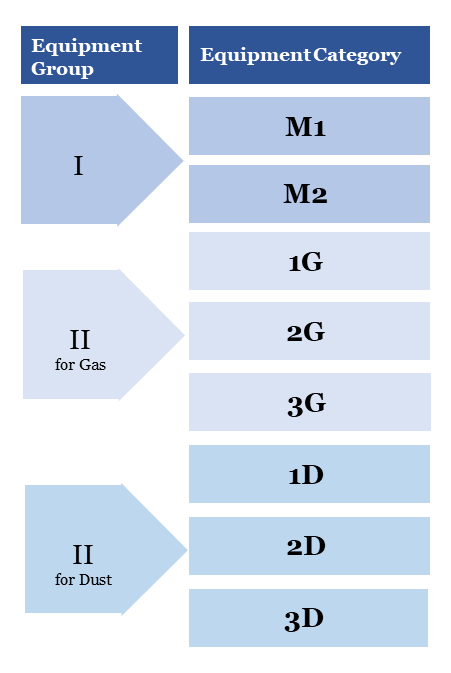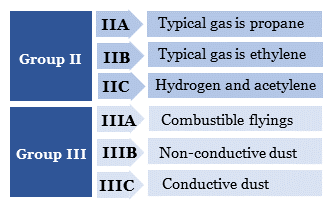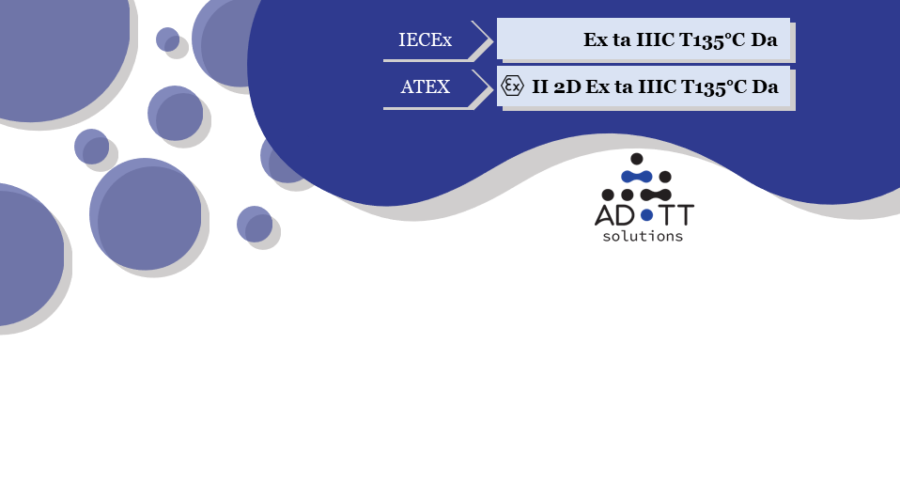- 2024-06-13
- Frida Kutasi
Demystifying IECEx and ATEX Marking String: Key Differences and What They Mean
IECEx and ATEX marking again? Why are you writing about this topic? I am easily able to find multiple similar-themed articles or blog posts, which ones already detail the information…
Yes, you are right! So, if you are able to understand this example you can continue your browsing for some more informative content (We would appreciate it if you check our other blog posts or even our website.).
Let’s see, do you know what this means?
Ex tb [ib Db] IIIC T135°C Db
If you feel a little bit confused, or you think you need to check the standard to decipher the meaning of it, just keep reading. I will help demystify the meaning of it or even a little bit more! Come with me Dear Reader into the coded world of IECEx and ATEX markings in EN IEC 60079-0 standard.
This explanation was written based on the order of use of the string’s characteristics.
Difference Between IECEx and ATEX Marking
There is a very simple and easily identifiable difference. The IECEx marking string is always the shorter one.
- Does not contain Ex icon and
- has fewer characters (and lacks CE mark).

Particularities of ATEX Marking String

Apart from the Ex icon and the CE marking, the ATEX-specific part of the string gives us information about the following:
-
1st Equipment Group (“II”)
-
2nd Equipment Category (“2D”)
Between the two categories always keep 1 space!
Equipment Group
Apart from the Ex icon and the CE marking, the ATEX-specific part of the string gives us information about the following:
-
1st Equipment Group (“II”)
-
2nd Equipment Category (“2D”)
Between the two categories always keep 1 space!

Equipment Category
Let’s crack the code on Equipment Category within explosion-proof equipment markings. Think of it as a nested category with a two-digit code: a letter and a number.
In Mines:
- The code starts with the letter “M” followed by a number (1 or 2).
- 1: Equipment designed for mines and must function even in an explosive atmosphere (tough stuff!).
- 2: Equipment for mines, but meant to be de-energized when there’s a risk of explosion (safety first!).
For Gas and Dust:
- The code flips the order, starting with a number (1, 2, or 3) followed by “G” for gas or “D” for dust.
- The number gets trickier here:
- 1: Non-mining, Zone0/20 (most hazardous)
- 2: Non-mining, Zone1/21
- 3: Non-mining, Zone2/22 (least hazardous)
While memorizing the exact code might be a challenge, the key takeaway is simple: lower numbers signify a higher level of explosion risk.
Explosion Protection

This will be a brief chapter. In every string (IECEx and ATEX too) “Ex” means: the product is explosion protected. At IECEx this is the first part of the marking string. At ATEX it follows the special ATEX characters.
Type of Protection and Level of Protection

So already, the marking string of this product is defined as explosion-protected (“Ex”). Subsequently, the type of protection method employed to ensure the product’s safety is indicated. Almost 10 different Types of Protection can be distinguished. Some of their names harmonize with the indicated letter of it. Like “i” intrinsic safe Type of Protection. But as usual, there are more differences. Check the picture for a better understanding.
The Level of Protection is derived from these. It is from 2 pcs letter:
-
the first is the Type of Protection (“d”) and
-
the second is for the hazardous environment where is allowed to place the product (“b”).
This environment indication here is based on letters not numbers as ATEX Equipment Category:
- “a” for Zone0/20,
- “b” for Zone1/21, and
- “c” for Zone2/22
Those letters need to be the same here (in most cases) and at the Equipment Protection Level (EPL)!

Gas Group and Dust Group Marking

Now we already know that the product is explosion-protected, how protected, and where can be found. Here comes the dust and gas protection specification. These string elements show specific characteristics in every variant.
- Group II stands for gas atmosphere.
- Group III for dust atmosphere.
In this classification, it is noteworthy that the gas and dust area “A” is less prone to ignition compared to the gas and dust areas “B” and “C”, and “C” being the most prone to ignition.

Temperature Classes

For Group I electrical equipment, the maximum surface temperature shall not exceed 150°C on any surface where coal dust may be present. If the equipment is protected from the coal dust (e.g. inside a dust-protected enclosure), then the maximum allowed surface temperature is 450°C. The temperature is not classified or otherwise indicated in the marking string.
In the IECEx and ATEX marking strings for Group II equipment, there are 6 different Temperature Classes between 450°C and 85°C for the maximum surface temperature. These values are to be assessed in the context of the ambient temperature where the product is to be used. Example: Ex ib IIC T4 Gb.
The interesting thing about the topic is that the larger the Temperature Class’s number, the smaller the value of the maximum surface temperature.
In Group III equipment, the maximum surface temperature that may appear on the equipment, must be indicated in the marking string. Example: Ex tb IIIC T135°C Db.
Equipment Protection Level

After this amount of information, I think you can already identify the last part of an IECEx or ATEX marking string. It contains 2 letters:
- the first is a capital letter in connection with Equipment Group (M-mine, G-gas, D-dust)
- the second indicates the Level of Protection (a-Zone0/20, b-Zone1/21, c-Zone2/22)
Ever wondered what those 2 letters are at the end of the string? Why do they repeat themselves? Let’s focus on the seemingly redundant last two characters (Gas Group: Ga, Gb, Gc, and Dust Group: Da, Db, Dc).
These characters combine info already given earlier in the code. But they’re not always useless! In some cases, they provide a bit extra:
- Alternate Marking: The code can specify a broader range of suitability. For example, “Ex ia IIC T4 Gb” indicates the equipment is certified for Zone0 („a”) but must installed in Zone1 („b”).
- Emphasis: Manufacturers might use the full code leaving no room for misinterpretation.
- Future-proofing: Standards evolve, and these characters might hold additional info in future revisions.
While the first part of the code often does the trick, these last characters can offer hidden value. Remember, always refer to the equipment documentation and relevant standards for the full picture.
Special Characteristics of IECEx and ATEX Marking Strings
We have arrived at the end of the “simple” marking string explanation. For deeper understanding let’s see some unique usage cases.
- Ex tb [ib Db] IIIC T135°C Db: as our first example. The square bracket content indicates that inside the dust-protected enclosure (“tb”) can connect intrinsic safe equipment from Zone1 (“ib”).
- Ex ia/tb IIIC T85°C Da/Db: Boundary wall installed equipment. Need to add a slash between the Level of Protection and the Equipment Protection Levels.
What does this mean? Test your knowledge about marking
Phew, that was a lot to unpack! Thanks for reading.
I hope now you feel more confident about IECEx and ATEX markings. I am presenting you with two cards. Try to figure out their meanings. After that, you can flip the card and check the result. Do not cheat! You can do it!
II 2D Ex tb ib IIC T85°C Db
It’s a WRONG one. Let’s see why:
- Ex icon missing, because the string looks like ATEX kind.
- The Level of protection (“tb” and “ib”) needs to be in alphabetic order.
- For the dust environment certification string the Equipment Grouping (IIC) needs to be IIIC.
Ex ib IIC T4 Gb
- It is an IECEx marking.
- The Type of Protection of the product is “i” intrinsic safety with a second letter indicating the Level of Protection “ib”. This means intrinsic safety for Zone1
- “IIC” for Gas group and the most ignitable type gas group
- “T4” is the Temperature Class and the maximum surface temperature +135°C
- The one: “Gb” for Equipment Protection Level. “G” as gas environment inside “b” as Zone1
Now you’re an expert on IECEx and ATEX markings! Time to share your knowledge.
If you need a handy help, you can download the following picture.


